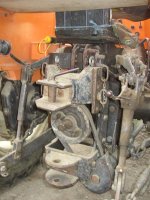Bird
Epic Contributor
Fifth wheel travel trailers generally have a much greater pin weight than the tongue weight of conventional travel trailers. So in my opinion it would be difficult, if not impossible, to answer the question about whether the tractor can handle it without knowing the pin weight of the trailer, perhaps total weight, and the 3-point lift capacity of the tractor, and whether there are counterweights on the front of the tractor.

